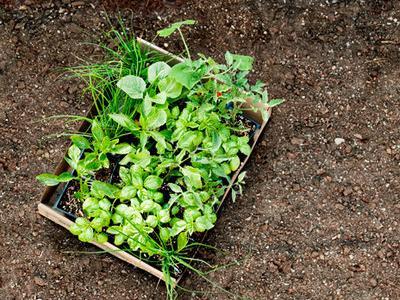How to plant an easy edible garden

Photo by Thomas J. Story
Plan and shop
Choose a spot that you can reach with your hose and gets at least six hours of sun a day. Sketch a plan, taking into account how large everything will be when fully grown—don’t jam the plants too close together—or follow our layout for a 4- by 8-foot bed, below. Then go buy your seedlings and enough bagged compost to spread a 6-inch-deep layer—we used 16 cubic feet.
Amend your soil

When you get home, water the seedlings thoroughly while they’re still in their plastic containers. Then spread compost over your entire planting bed. Mix it in with a digging fork, removing any rocks, and rake the area flat—this will help water soak in evenly. Now break for a long lunch.
Plant and water

After the heat of the day has passed, set out the seedlings according to your plan. Tip plants out from their pots and gently loosen any matted roots with your fingers, then plant each seedling so that the top of its rootball is level with the soil. Water your new garden well, even though it’s late afternoon (usually, you’ll want to water it in early morning).
Watch it grow

Things will really take off when the weather gets even warmer—in about six to eight weeks, your garden should start looking like the one pictured.
Tend your garden

You want the soil to feel moist but not soggy. For the first few weeks, this could mean daily watering or more, depending on the weather. Then, if it’s not unusually hot, you can probably taper off to every second or third day; just don’t let the soil dry out. Also, pinch off basil flower buds as they appear.
Harvest

In general, pick each vegetable when it looks like it does at the market. Wait until tomatoes reach their full color. Pick cucumbers even if you aren’t going to use them—it keeps the plants producing.
Related news
 Growing Potatoes in Containers: A Roundup of the Best Ideas
Growing Potatoes in Containers: A Roundup of the Best Ideas Potatoes are widely available in grocery stores and reasonably priced, but there’s something magical about growing them at home
 When to Plant Elephant Ear Bulbs
When to Plant Elephant Ear Bulbs Colocasia, also known as elephant ears or taro, make spectacular landscaping plants. Their long stalks and large, luxurious leaves add a tropical feel
 Are Elephant Ear Plants Poisonous?
Are Elephant Ear Plants Poisonous? Here’s a puzzle for you: what plant is toxic, yet serves as a major food source for many countries in Asia? The answer: Colocasia, also known as elephant ear
 Diseases of Zucchini Plants
Diseases of Zucchini Plants With such a glut of zucchini, it’s hard to believe that these popular vegetables are subject to a whole host of destructive diseases.
 Growing Roses from Collected Seeds
Growing Roses from Collected Seeds Roses are probably the most popular flower grown by organic gardeners, given their beauty, scent, and hardiness.